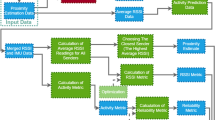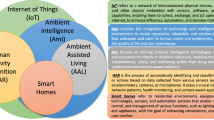Abstract
Multiple location-based device-free activity recognition systems indicate that some activities related to specific locations can be inferred from the location system and adding location information can improve the accuracy of activity recognition. Therefore, localization technology is the basis for activity recognition and other applications. Radio-Map is an effective measure in Device-free localization (DFL). Traditional fingerprint systems that can provide such accuracy are suffering from human cost in Radio-Map construction and update. Although the human cost in update phase has been paid attention, the higher costs caused by the initially created are ignored. In addition, existing systems assume that RSS change measurements caused by different targets are fixed distribution in any region. The two drawbacks will greatly affect the practicability and robustness of Radio-Map. In this paper, we propose, DTransfer, an extremely low-cost DFL approach that localize different kinds of targets in different regions. We design an optimized low-rank matrix completion model based on singular value decomposition (SVD) to construct the sensing matrix (i.e., radio-map) of the original region, which greatly reduces the overhead. Next, we employ a rigorously designed quadratic transfer scheme to accurately locate different categories of targets in different regions. Finally, we apply the location information to the activity recognition algorithm; experiments have shown that the accuracy of the algorithm for adding location information is increased by approximately 6%. Extensive experimental results illustrate that DTransfer achieves delightful performance.













Similar content being viewed by others
References
Wang Z, Guo B, Yu Z et al (2017) Wi-fi csi based behavior recognition: from signals, actions to activities. IEEE Commun Mag arXiv:1712.00146v1
Yang D, Zhang D, Qu B (2016) Participatory cultural mapping based on collective behavior data in location-based social networks. ACM Trans Intell Syst Technol 7(3):3001–3023
Zhang D, Wang H, Wu D (2017) Toward centimeter-scale human activity sensing with Wi-fi signals. Computer 50(1):48–57
Wu D, Zhang D, Xu C, Wang H, Li X (2017) Device-free wifi human sensing: from pattern-based to model-based approaches. IEEE Commun Mag 55(10):91–97
Chen C, Zhang D, Sun L et al (2012) Does location help daily activity recognition? Lect Notes Comput Sci 7251:83–90
Virmani A and Shahzad M (2017) Position and orientation agnostic gesture recognition using wifi. In: International Conference on Mobile Systems, Applications, and Services, pp 252–264
Kim DH, Lee J, Yoon Y et al (2013) Hridemon: a framework for recognition of human location, identity and behavior in human-robot interaction. In: International Conference on Ubiquitous Robots and Ambient Intelligence, pp 533–534
Li Z and Liu Y (2018) aleak: Privacy leakage through context-free wearable side-channel. In International Conference on Computer Communications, pp 110–118
Guo B, Han Q, Chen H, Shangguan L, Zhou Z, Yu Z (2017) The emergence of visual crowdsensing: challenges and opportunities. IEEE Commun Surv Tutor 19(4):2526–2543
Guo B, Wang Z, Yu Z, Wang Y, Yen WY, Huang R, Zhou X (2015) Mobile crowd sensing and computing: the review of an emerging human-powered sensing paradigm. ACM Comput Surv 48(1):1:01–1:33
Li Z, Xie Y, Li M and Jamieson K (2015) Recitation: rehearsing wireless packet reception in software. In: International Conference on Mobile Computing and Networking, pp 291–303
Xiong J, Sundaresan K, and Jamieson K (2015) Tonetrack: leveraging frequency-agile radios for time-based indoor wireless localization. In: International Conference on Mobile Computing and Networking, pp 537–549
Youssef M, Mah M, and Agrawala A (2007) Challenges: device-free passive localization for wireless environments. In: International Conference on Mobile Computing and Networking, pp 222–229
Seifeldin M, Saeed A, Ahmed E et al (2013) Nuzzer: a large-scale device-free passive localization system for wireless environments. IEEE Trans Mob Comput 12(7):1321–1334
Wilson J, Patwari N (2010) Radio tomographic imaging with wireless networks. IEEE Trans Mob Comput 9(5):621–632
Kotaru M, Joshi K, Bharadia D, Katti S (2015) Spotfi:decimeter level localization using wifi. Comput Commun Rev 45(4):269–282
Wilson J, Patwari N (2011) See-through walls: motion tracking using variance-based radio tomography networks. IEEE Trans Mob Comput 10(5):612–621
Zhang D, Liu Y, and Ni LM (2011) Rass: A real-time, accurate and scalable system for tracking transceiver- free objects. In: International Conference on Pervasive Computing and Communications, pp 197–204
Pan S, Shen D, Yang Q et al (2008) Transferring localization models across space. In: National Conference on Artificial Intelligence, pp 1383–1388
Pan S, Zheng V, Yang, Q et al (2008). Transfer learning for wifi-based indoor localization. In: international conference on Association for the Advancement of artificial, pp 43–48
Zheng V, Pan S, Yang Q, and Pan J (2008) Transferring multidevice localization models using latent multi-task learning. In: National Conference on Artificial Intelligence, pp 1427–1432
Chang L, Chen X, Wang Y, Fang D, Wang J, Xing T, Tang Z (2016) Fitloc: fine-grained and low-cost device-free localization for multiple targets over various areas. IEEE/ACM Trans Networking 25(4):1994–2007
Needell D, Vershynin R (2010) Signal recovery from incomplete and inaccurate measurements via regularized orthogonal matching pursuit. IEEE J-STSP 4(2):310–316
Wang J, Gao Q, Wang H, Cheng P, Xin K (2015) Device-free localization with multidimensional wireless link information. IEEE Trans Veh Technol 64(1):356–366
Wang J, Fang D, Chen X, and Yang Z (2013) Lcs: compressive sensing based device-free localization for multiple targets in sensor networks. In International Conference on Computer Communications, pp 145–149
Murata N, Takenouchi T, Kanamori T, Eguchi S (2004) Information geometry of u-boost and bregman divergence. Neural Comput 16(7):1437–1481
Shu Y, Kang GS, He T, and Chen J (2015) Last-mile navigation using smartphones. International Conference on Mobile Computing and Networking, pp 512–524
Wang J, Chen X, Fang D, Wu C et al (2015) Transferring compressive-sensing-based device-free localization across target diversity. IEEE Trans Ind Electron 62(4):2397–2409
Gangeh MJ, Sadeghinaini A, Diu M, Tadayyon H, Kamel MS, Czarnota GJ (2014) Categorizing extent of tumor cell death response to cancer therapy using quantitative ultrasound spectroscopy and maximum mean discrepancy. IEEE Trans Med Imaging 33(6):1390–1400
Zhu X, Kandola JS, Ghahramani Z, and Lafferty DJ (2005) Nonparametric transforms of graph kernels for semi-supervised learning. In: Neural Information Processing Systems Foundation, pp 1641–1648
Candes EJ, Recht B (2012) Exact matrix completion via convex optimization. Found Comput Math 9:717–772. https://doi.org/10.1007/s10208-009-9045-5
Wang Y, Liu J, Chen Y, Gruteser M, Yang J, and Liu H (2014) E-eyes: device-free location-oriented activity identification using fine- grained wifi signatures. In: International Conference on Mobile Computing and Networking, pp 617–628
Abdelnasser H, Youssef M, and Harras KA (2015) Wigest: a ubiquitous wifi-based gesture recognition system. In: IEEE Conference on Computer Communications, pp 1472–1480
Zheng X, Wang J, Shangguan L, Zhou Z, Liu Y (2017) Design and implementation of a CSI-based ubiquitous smoking detection system. IEEE/ACM Trans Networking 25(6):3781–3793
Wang W, Liu A, Shahzad M, Ling K, Lu S (2017) Device-free human activity recognition using commercial wifi devices. IEEE J Sel Area Comm 35(5):1118–1131
Aggarwal JK, Ryoo MS (2014) Human activity analysis: a review. ACM Comput Surv 43(3):1–43
Lien J, Gillian N, Karagozler EM, Amihood P et al (2016) Soli: ubiquitous gesture sensing with millimeter wave radar. ACM Trans Graph 35(4):14201–14219
Raij A, Stohs N, Al’Absi M, Kumar S, and Mitra S (2011) Demo: an unobtrusively wearable sensor suite for inferring the onset, causality, and consequences of stress in the field. In: ACM Conference on Embedded Networked Sensor Systems, pp 437–438
Yatani K and Truong KN (2012) Bodyscope: a wearable acoustic sensor for activity recognition. In: ACM Conference on Ubiquitous Computing, pp 341–350
Liao L, Fox D, and Kautz H (2005) Location-based activity recognition using relational markov networks. In: International Conference on Artificial Intelligence, pp 773–778
Acknowledgements
This work is supported by Project NSFC (61602381, 61501372, and 61672428), China Postdoctoral Science Foundation (2017M613187 and 2017M613186), and Natural Science Basis Research Plan in Shaanxi Province of China (2017JM6074).
Author information
Authors and Affiliations
Corresponding author
Rights and permissions
About this article
Cite this article
Wang, Q., Yin, X., Tan, J. et al. DTransfer: extremely low cost localization irrelevant to targets and regions for activity recognition. Pers Ubiquit Comput 23, 3–16 (2019). https://doi.org/10.1007/s00779-018-1177-7
Received:
Accepted:
Published:
Issue Date:
DOI: https://doi.org/10.1007/s00779-018-1177-7




